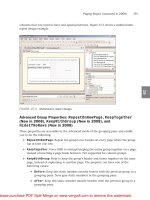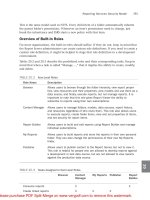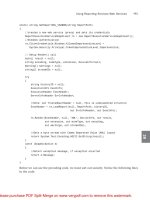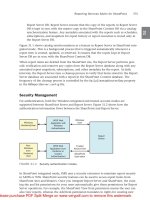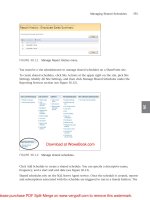Tài liệu Wiley - Microsoft SQL Server 2008 For Dummies (2008)01 doc
Bạn đang xem bản rút gọn của tài liệu. Xem và tải ngay bản đầy đủ của tài liệu tại đây (768.06 KB, 40 trang )
by Mike Chapple
Microsoft
®
SQL
Server
®
2008
FOR
DUMmIES
‰
01_224656-ffirs.indd iii01_224656-ffirs.indd iii 8/21/08 5:25:01 PM8/21/08 5:25:01 PM
01_224656-ffirs.indd ii01_224656-ffirs.indd ii 8/21/08 5:25:01 PM8/21/08 5:25:01 PM
Microsoft
®
SQL
Server
®
2008
FOR
DUMmIES
‰
01_224656-ffirs.indd i01_224656-ffirs.indd i 8/21/08 5:25:01 PM8/21/08 5:25:01 PM
01_224656-ffirs.indd ii01_224656-ffirs.indd ii 8/21/08 5:25:01 PM8/21/08 5:25:01 PM
by Mike Chapple
Microsoft
®
SQL
Server
®
2008
FOR
DUMmIES
‰
01_224656-ffirs.indd iii01_224656-ffirs.indd iii 8/21/08 5:25:01 PM8/21/08 5:25:01 PM
Microsoft
®
SQL Server
®
2008 For Dummies
®
Published by
Wiley Publishing, Inc.
111 River Street
Hoboken, NJ 07030-5774
www.wiley.com
Copyright © 2008 by Wiley Publishing, Inc., Indianapolis, Indiana
Published by Wiley Publishing, Inc., Indianapolis, Indiana
Published simultaneously in Canada
No part of this publication may be reproduced, stored in a retrieval system or transmitted in any form or
by any means, electronic, mechanical, photocopying, recording, scanning or otherwise, except as permit-
ted under Sections 107 or 108 of the 1976 United States Copyright Act, without either the prior written
permission of the Publisher, or authorization through payment of the appropriate per-copy fee to the
Copyright Clearance Center, 222 Rosewood Drive, Danvers, MA 01923, (978) 750-8400, fax (978) 646-8600.
Requests to the Publisher for permission should be addressed to the Legal Department, Wiley Publishing,
Inc., 10475 Crosspoint Blvd., Indianapolis, IN 46256, (317) 572-3447, fax (317) 572-4355, or online at
/>Trademarks: Wiley, the Wiley Publishing logo, For Dummies, the Dummies Man logo, A Reference for the
Rest of Us!, The Dummies Way, Dummies Daily, The Fun and Easy Way, Dummies.com, Making Everything
Easier, and related trade dress are trademarks or registered trademarks of John Wiley & Sons, Inc., and/
or its affiliates in the United States and other countries, and may not be used without written permission.
SQL Server is a registered trademark of Microsoft Corporation in the United States and/or other countries.
All other trademarks are the property of their respective owners. Wiley Publishing, Inc., is not associated
with any product or vendor mentioned in this book.
LIMIT OF LIABILITY/DISCLAIMER OF WARRANTY: THE PUBLISHER AND THE AUTHOR MAKE NO
REPRESENTATIONS OR WARRANTIES WITH RESPECT TO THE ACCURACY OR COMPLETENESS OF
THE CONTENTS OF THIS WORK AND SPECIFICALLY DISCLAIM ALL WARRANTIES, INCLUDING WITH-
OUT LIMITATION WARRANTIES OF FITNESS FOR A PARTICULAR PURPOSE. NO WARRANTY MAY BE
CREATED OR EXTENDED BY SALES OR PROMOTIONAL MATERIALS. THE ADVICE AND STRATEGIES
CONTAINED HEREIN MAY NOT BE SUITABLE FOR EVERY SITUATION. THIS WORK IS SOLD WITH THE
UNDERSTANDING THAT THE PUBLISHER IS NOT ENGAGED IN RENDERING LEGAL, ACCOUNTING, OR
OTHER PROFESSIONAL SERVICES. IF PROFESSIONAL ASSISTANCE IS REQUIRED, THE SERVICES OF
A COMPETENT PROFESSIONAL PERSON SHOULD BE SOUGHT. NEITHER THE PUBLISHER NOR THE
AUTHOR SHALL BE LIABLE FOR DAMAGES ARISING HEREFROM. THE FACT THAT AN ORGANIZA-
TION OR WEBSITE IS REFERRED TO IN THIS WORK AS A CITATION AND/OR A POTENTIAL SOURCE
OF FURTHER INFORMATION DOES NOT MEAN THAT THE AUTHOR OR THE PUBLISHER ENDORSES
THE INFORMATION THE ORGANIZATION OR WEBSITE MAY PROVIDE OR RECOMMENDATIONS IT
MAY MAKE. FURTHER, READERS SHOULD BE AWARE THAT INTERNET WEBSITES LISTED IN THIS
WORK MAY HAVE CHANGED OR DISAPPEARED BETWEEN WHEN THIS WORK WAS WRITTEN AND
WHEN IT IS READ.
For general information on our other products and services, please contact our Customer Care
Department within the U.S. at 800-762-2974, outside the U.S. at 317-572-3993, or fax 317-572-4002.
For technical support, please visit www.wiley.com/techsupport.
Wiley also publishes its books in a variety of electronic formats. Some content that appears in print may
not be available in electronic books.
Library of Congress Control Number: 2008933745
ISBN: 978-0-470-22465-6
Manufactured in the United States of America
10 9 8 7 6 5 4 3 2 1
01_224656-ffirs.indd iv01_224656-ffirs.indd iv 8/21/08 5:25:01 PM8/21/08 5:25:01 PM
About the Author
Mike Chapple, MCDBA, CISA, CISSP is an IT professional with over ten
years’ experience with SQL Server. He currently serves as an IT profes-
sional with the University of Notre Dame, where he also teaches an
undergraduate computer applications course. Mike actively participates
as a subject matter expert in the SQL Server community and writes
extensively on SQL Server at the About.com Guide to Databases. He also
serves on the Center for Internet Security SQL Server security standard
development team.
Mike is a technical editor for Information Security Magazine and is author
of several books, including Information Security Illuminated and the CISSP
Prep Guide. Mike holds a BS in computer science from the University of
Notre Dame, an MS in computer science from the University of Idaho,
and an MBA from Auburn University.
01_224656-ffirs.indd v01_224656-ffirs.indd v 8/21/08 5:25:02 PM8/21/08 5:25:02 PM
01_224656-ffirs.indd vi01_224656-ffirs.indd vi 8/21/08 5:25:02 PM8/21/08 5:25:02 PM
Dedication
To my family: Renee, Richard, Matthew, and Christopher who
lovingly put up with me during the hours I spent buried in my
laptop writing this book.
Author’s Acknowledgments
I would like to thank Kyle Looper and Susan Christophersen,
my editors at Wiley, who provided me with invaluable assis-
tance throughout the book development process. I also owe a
debt of gratitude to my literary agent, Carole Jelen of Waterside
Productions. Doug Couch served as technical editor for this title
and was a great source of advice as we worked through some of
the more difficult portions of the book. I’d also like to thank the
many people who participated in the production of this book but
I never had the chance to meet: the graphics team, production
staff, and all those involved in bringing this book to press.
01_224656-ffirs.indd vii01_224656-ffirs.indd vii 8/21/08 5:25:02 PM8/21/08 5:25:02 PM
Publisher’s Acknowledgments
We’re proud of this book; please send us your comments through our online registration form
located at
www.dummies.com/register/.
Some of the people who helped bring this book to market include the following:
Acquisitions, Editorial, and
Media Development
Project Editor: Susan Christophersen
Acquisitions Editor: Kyle Looper
Copy Editor: Susan Christophersen
Technical Editor: Doug Couch
Editorial Manager: Jodi Jensen
Editorial Assistant: Amanda Foxworth
Sr. Editorial Assistant: Cherie Case
Cartoons: Rich Tennant
(
www.the5thwave.com)
Composition Services
Project Coordinator: Katherine Key
Layout and Graphics: Carl Byers,
Reuben W. Davis
Proofreader: Toni Settle
Indexer: Broccoli Information Management
Publishing and Editorial for Technology Dummies
Richard Swadley, Vice President and Executive Group Publisher
Andy Cummings, Vice President and Publisher
Mary Bednarek, Executive Acquisitions Director
Mary C. Corder, Editorial Director
Publishing for Consumer Dummies
Diane Graves Steele, Vice President and Publisher
Joyce Pepple, Acquisitions Director
Composition Services
Gerry Fahey, Vice President of Production Services
Debbie Stailey, Director of Composition Services
01_224656-ffirs.indd viii01_224656-ffirs.indd viii 8/21/08 5:25:02 PM8/21/08 5:25:02 PM
Contents at a Glance
Introduction 1
Part I: Welcome to SQL Server 2008 7
Chapter 1: Introducing SQL Server 2008 9
Chapter 2: Building Your SQL Server 19
Chapter 3: Working with SQL Server Tools 35
Part II: Building SQL Server 2008 Databases 49
Chapter 4: Planning Your Database 51
Chapter 5: Creating Databases and Tables 73
Chapter 6: Imposing Constraints and Relationships 91
Part III: Retrieving Data from Databases 107
Chapter 7: Constructing Simple Database Queries 109
Chapter 8: Joins and Other Advanced Queries 127
Chapter 9: Turning Data into Information with SQL Server
Reporting Services 143
Part IV: Inserting and Manipulating Your Data 159
Chapter 10: Inserting, Updating, and Deleting Data 161
Chapter 11: Saving Time with Functions, Stored Procedures, and Triggers 175
Part V: SQL Server Administration 191
Chapter 12: Keeping Your SQL Server Running Smoothly 193
Chapter 13: Automating SQL Server 2008 Administration 213
Chapter 14: Troubleshooting SQL Server 2008 Problems 233
Chapter 15: Replicating Data across Multiple Servers 249
Part VI: Protecting Your Data 269
Chapter 16: Protecting Your Data from Prying Eyes 271
Chapter 17: Preserving the Integrity of Your Transactions 293
Chapter 18: Preparing for Disaster 305
Chapter 19: Staying Alive: High Availability in SQL Server 2008 323
Chapter 20: Implementing Policy-Based Management with the Declarative
Management Framework 339
02_224656-ftoc.indd ix02_224656-ftoc.indd ix 8/21/08 5:25:26 PM8/21/08 5:25:26 PM
Part VII: The Part of Tens 351
Chapter 21: Ten Ways to Keep Your SQL Server 2008 Databases Humming 353
Chapter 22: Ten Database Design Tips 359
Index 363
02_224656-ftoc.indd x02_224656-ftoc.indd x 8/21/08 5:25:27 PM8/21/08 5:25:27 PM
Table of Contents
Introduction 1
About This Book 1
Conventions Used in This Book 2
What You Are Not to Read 2
Foolish Assumptions 3
How This Book Is Organized 3
Icons Used in This Book 5
Where to Go from Here 5
Part I: Welcome to SQL Server 2008 7
Chapter 1: Introducing SQL Server 2008. . . . . . . . . . . . . . . . . . . . . . . . . . .9
Starting Off on the Right Foot 10
Examining SQL Server editions 10
Checking system requirements 11
Understanding the Basic Components of SQL Server 13
SQL and Transact-SQL 13
SQL Server components 13
Implementing Databases with SQL Server 2008 16
Setting up your server 16
Stocking it with databases 16
Accessing and updating your data 16
Managing and protecting what you’ve built 17
What’s New in SQL Server 2008 17
Declarative Management Framework 17
Encryption and Auditing 18
Resource conservation 18
Date/Time Data Types 18
Chapter 2: Building Your SQL Server . . . . . . . . . . . . . . . . . . . . . . . . . . . .19
Installing SQL Server 2008 19
Choosing between default and named instances 19
Selecting an authentication mode 20
Choosing service accounts 21
Selecting the collation 21
Performing the installation 22
02_224656-ftoc.indd xi02_224656-ftoc.indd xi 8/21/08 5:25:27 PM8/21/08 5:25:27 PM
Microsoft SQL Server 2008 For Dummies
xii
Upgrading an Existing SQL Server Installation 25
Preparing for an upgrade with Upgrade Advisor 26
Upgrading Your Installation 27
Configuring Database Mail 28
Using SQL Server’s Built-In Databases 33
Master database 33
The msdb database 33
The model database 34
The tempdb database 34
Chapter 3: Working with SQL Server Tools. . . . . . . . . . . . . . . . . . . . . . .35
Using SQL Server Configuration Manager 35
Launching SQL Server Configuration Manager 36
Starting and stopping services 36
Changing service accounts 38
Changing service start modes 39
Modifying networking settings 40
Managing Your Server with SQL Server Management Studio 43
Starting SSMS and connecting to an instance 43
Exploring the SSMS Interface 44
Issuing Transact-SQL queries 45
Working from the Command Line 46
Part II: Building SQL Server 2008 Databases 49
Chapter 4: Planning Your Database . . . . . . . . . . . . . . . . . . . . . . . . . . . . .51
Introducing Database Design Concepts 51
Understanding the Elementsof a Database 52
Database servers 52
Organizing a Database 55
Defining your database objectives 55
Grouping data into tables 56
Selecting primary keys 59
Linking related tables 60
Diagramming Your Database 61
Staying Fit and Trim with Normalization 62
First normal form 62
Second and third normal forms 63
Choosing Data Types for Your Tables 64
Numeric data types 65
Date and time data types 66
Character string data types 68
Binary data types 69
Other data types 69
Working with NULL Values 70
02_224656-ftoc.indd xii02_224656-ftoc.indd xii 8/21/08 5:25:27 PM8/21/08 5:25:27 PM
xiii
Table of Contents
Chapter 5: Creating Databases and Tables . . . . . . . . . . . . . . . . . . . . . . .73
Creating a Database 73
Altering database properties 77
Deleting or renaming a database 78
Specifying Files and Filegroups 80
SQL Server files 80
Using filegroups 83
Creating a Table 85
Getting started 85
Adding columns 87
Selecting a primary key 87
Modifying tables 89
Deleting tables 90
Chapter 6: Imposing Constraints and Relationships . . . . . . . . . . . . . . .91
Introducing Constraints 91
Controlling Database Contents Using Constraints 92
Filling in empty values with DEFAULT constraints 92
Enforcing Database Integrity 102
Enforcing uniqueness 102
Enforcing referential integrity with FOREIGN KEY constraints 103
Part III: Retrieving Data from Databases 107
Chapter 7: Constructing Simple Database Queries . . . . . . . . . . . . . . .109
Retrieving Data with SELECT Statements 109
The SELECT. . .FROM clause 110
The WHERE clause 112
Organizing Query Results 118
Sorting output 118
Summarizing data with aggregate functions 120
Grouping results 123
Renaming columns in your output 124
Chapter 8: Joins and Other Advanced Queries. . . . . . . . . . . . . . . . . . .127
Joining Data from Multiple Tables 127
Matching records with INNER JOINs 128
Including nonmatching records with OUTER JOINs 131
Joining a table with itself 133
Taking SELECT to the Next Level 135
Computing values 135
Managing complexity with subqueries 137
Dealing with different cases 138
02_224656-ftoc.indd xiii02_224656-ftoc.indd xiii 8/21/08 5:25:27 PM8/21/08 5:25:27 PM
Microsoft SQL Server 2008 For Dummies
xiv
Using Database Views 139
Creating a view 139
Modifying a view 140
Deleting a view 141
Chapter 9: Turning Data into Information
with SQL Server Reporting Services . . . . . . . . . . . . . . . . . . . . . . . . . . .143
Setting up SQL Server Reporting Services 143
Creating an SSRS Report with Report Builder 146
Installing and starting Report Builder 2.0 147
Choosing a data source and data set 147
Laying out the report 150
Publishing the report 154
Working with Deployed (Published) Reports 154
Viewing reports 155
Configuring report security 156
Part IV: Inserting and Manipulating Your Data 159
Chapter 10: Inserting, Updating, and Deleting Data . . . . . . . . . . . . . .161
Inserting Small Quantities of Data 161
Understanding simple data entry 162
Writing INSERT statements 163
Modifying and Deleting Data 164
Modifying data with UPDATE 164
Removing data from a database 165
Importing Large Quantities of Data 166
Inserting query results 166
Copying bulk data with BULK INSERT 167
Performing blk operations from the command line with bcp 168
Working with SQL Server Integration Services 169
Chapter 11: Saving Time with Functions,
Stored Procedures, and Triggers . . . . . . . . . . . . . . . . . . . . . . . . . . . . . .175
Reusing Logic with Functions 175
Understanding types of functions 176
Leveraging SQL Server’s built-in functions 177
Calling built-in functions 178
Obtaining a list of built-in functions 179
Creating Your Own Functions 181
Reusing SQL Code with Stored Procedures 183
Saving time with system stored procedures 184
Writing your own stored procedures 185
02_224656-ftoc.indd xiv02_224656-ftoc.indd xiv 8/21/08 5:25:27 PM8/21/08 5:25:27 PM
xv
Table of Contents
Updating Data Automatically with Triggers 187
Creating a trigger 188
Disabling a trigger 189
Modifying and Deleting Functions, Stored Procedures,
and Triggers 189
Modifying objects 189
Deleting objects 190
Part V: SQL Server Administration 191
Chapter 12: Keeping Your SQL Server Running Smoothly . . . . . . . . .193
Indexing Data to Improve Query Performance 193
Using clustered indexes 194
Creating nonclustered indexes 194
Optimizing index performance 197
Improving Performance with Partitions 198
Creating a partition function 199
Creating a partition scheme 200
Creating a partitioned table 201
Updating Database Statistics 202
Automatically updating statistics 202
Manually updating statistics 202
Managing File Sizes 203
Automatically shrinking database files 203
Manually shrinking a single database file 204
Manually shrinking all files associated with a database 204
Checking Database Integrity 205
Running DBCC CHECKDB 205
Correcting integrity errors 206
Governing Resource Consumption 207
Creating resource pools 208
Creating workload groups 210
Creating classifier functions 211
Activating and deactivating Resource Governor 212
Chapter 13: Automating SQL Server 2008 Administration. . . . . . . . . .213
Scheduling Tasks with SQL Server Agent 213
Starting SQL Server Agent 214
Creating a SQL Server Agent job 215
Adding job steps to a SQL Server Agent job 217
Scheduling a SQL Server Agent job 220
Notifying someone when the job completes 222
Implementing Database Maintenance Plans 222
Identifying the tasks to include in a maintenance plan 223
Creating a maintenance plan 223
02_224656-ftoc.indd xv02_224656-ftoc.indd xv 8/21/08 5:25:27 PM8/21/08 5:25:27 PM
Microsoft SQL Server 2008 For Dummies
xvi
Alerting Administrators about Database Events 228
Configuring database operators 228
Creating SQL Server alerts 229
Chapter 14: Troubleshooting SQL Server 2008 Problems . . . . . . . . . .233
Understanding the Inner Workings of SQL Server Queries 233
Creating a trace with SQL Server Profiler 234
Reviewing trace results 237
Reviewing Log Records 238
SQL Server error log 239
Windows Application Log 239
SQL Server Management Studio Log File Viewer 240
Monitoring Your Server with Performance Studio 241
Configuring Performance Studio 242
Reviewing performance data 244
Tuning Your Database with Database Engine Tuning Advisor 246
Chapter 15: Replicating Data across Multiple Servers. . . . . . . . . . . .249
Understanding Replication 250
Server roles 250
Articles and publications 252
Replication types 254
Publishing Data with Snapshot Replication 258
Creating a distributor 258
Creating a publication 261
Subscribing to a Publication 265
Monitoring Replication 267
Part VI: Protecting Your Data 269
Chapter 16: Protecting Your Data from Prying Eyes . . . . . . . . . . . . . .271
Creating and Managing Logins 271
Creating server logins 272
Removing database logins 273
Adding Database Users 273
Managing Rights with Roles 275
Understanding fixed server roles 275
Understanding fixed database roles 277
Creating database roles 279
Assigning users to database roles 282
Preserving Confidentiality with Encryption 282
Encrypting database connections 283
Encrypting stored data 284
02_224656-ftoc.indd xvi02_224656-ftoc.indd xvi 8/21/08 5:25:27 PM8/21/08 5:25:27 PM
xvii
Table of Contents
Auditing SQL Server Activity 287
Enabling and configuring auditing 287
Reviewing audit records 291
Chapter 17: Preserving the Integrity of Your Transactions . . . . . . . .293
Preserving Transaction Integrity with the ACID Model 294
Atomicity 294
Consistency 295
Isolation 295
Durability 296
Creating SQL Server Transactions 296
COMMIT or ROLLBACK? 297
Testing Transact-SQL statements with transactions 298
Changing the Transaction Isolation Level 300
READ UNCOMMITTED 300
READ COMMITTED 301
REPEATABLE READ 301
SERIALIZABLE 302
SNAPSHOT 302
Handling Errors 303
Chapter 18: Preparing for Disaster . . . . . . . . . . . . . . . . . . . . . . . . . . . . .305
Backing Up Your Data 305
Backing up databases 306
Saving time with differential backups 309
Saving space with backup compression 310
Backing up the transaction log 312
Specifying Disaster Recovery Requirements with Recovery Models 315
Choosing a recovery model 315
Changing recovery models 316
Restoring Your Data after a Disaster 317
Using Database Snapshots 320
Creating a database snapshot 320
Accessing a database snapshot 321
Reverting to a database snapshot 321
Chapter 19: Staying Alive: High Availability in SQL Server 2008 . . .323
Creating Redundancy with Database Mirroring 324
Choosing an operating mode 325
Configuring mirroring 325
Monitoring Database Mirroring 330
Failing over a mirrored database 331
Synchronizing Databases with Log Shipping 333
Configuring log shipping 333
Failing over to a log shipping secondary instance 337
02_224656-ftoc.indd xvii02_224656-ftoc.indd xvii 8/21/08 5:25:27 PM8/21/08 5:25:27 PM
Microsoft SQL Server 2008 For Dummies
xviii
Chapter 20: Implementing Policy-Based Management
with the Declarative Management Framework . . . . . . . . . . . . . . . . . .339
Coming to Terms with DMF 340
Creating DMF Policies 340
Creating a condition 341
Creating a policy 344
Using On Demand Execution Mode 346
Verifying policy compliance 347
Enforcing a policy manually 348
Automated Policy Enforcement 349
Viewing Policies Affecting a Target 350
Part VII: The Part of Tens 351
Chapter 21: Ten Ways to Keep Your SQL
Server 2008 Databases Humming . . . . . . . . . . . . . . . . . . . . . . . . . . . . . .353
Monitor Query Performance 353
Back Up Your Data Routinely 354
Verify Database Integrity Often 354
Tune the Physical Structure of Your Databases 354
Conserve Transaction Log Disk Space 355
Monitor Database Logs 355
Automate Administrative Alerts 356
Manage Multiple Servers 356
Simplify User Rights Administration with Roles 356
Perform Security Reviews 357
Chapter 22: Ten Database Design Tips. . . . . . . . . . . . . . . . . . . . . . . . . .359
Plan Ahead 359
Draw Before You Click 360
Choose Primary Keys Carefully 360
Select Data Types with Space Efficiency in Mind 360
Make Sure Your Fields Are Single Purpose 361
Remember the Meaning of NULL 361
Normalize when Possible 361
Manage Your Relationships 362
Use Descriptive Names 362
Document Your Design 362
Index 363
02_224656-ftoc.indd xviii02_224656-ftoc.indd xviii 8/21/08 5:25:27 PM8/21/08 5:25:27 PM
Introduction
I
’ve been using SQL Server for longer than I care to admit. Let’s just say
that I remember the days when Microsoft first released its own version of
SQL Server after obtaining the rights to it from Sybase Corporation. That was
a long time ago!
Why have I been using SQL Server for such a long time? Quite simply, I
believe in its power as a user- and business-friendly database platform that’s
readily accessible to users in most modern enterprises. It’s much more pow-
erful than desktop databases such as Microsoft Access, and it’s rapidly gain-
ing market share over the industry leader, Oracle.
SQL Server is unique in that it easily accommodates users with a wide range
of experience. If you’re upgrading from Microsoft Access, you’ll find many
of SQL Server’s graphical user interfaces friendly and familiar. On the other
hand, if you’re a database professional moving from another platform, you’ll
find that the ability to directly issue commands to the database accelerates
your learning curve.
About This Book
This book provides you with an introduction to many of the commonly used
features of SQL Server 2008. You’ll find that it’s an excellent starting point for
anyone beginning to use SQL Server and offers a great foundation for your
database career. Some of the important issues I cover in this book include:
ߜ Choosing the appropriate edition of SQL Server for your needs
ߜ Orienting yourself to the SQL Server database management tools
ߜ Installing and configuring your first SQL Server 2008 database server
ߜ Designing your first database
ߜ Creating databases and tables in SQL Server 2008
ߜ Imposing constraints on database tables and creating inter-table
relationships
ߜ Retrieving data from your database with simple and advanced Transact-
SQL queries
03_224656-intro.indd 103_224656-intro.indd 1 8/21/08 5:25:54 PM8/21/08 5:25:54 PM
2
Microsoft SQL Server 2008 For Dummies
ߜ Creating basic reports with SQL Server Reporting Services
ߜ Inserting data into your database via manual or bulk insertion
ߜ Using stored procedures, functions and triggers to automate database
tasks
ߜ Keeping your database server running smoothly with indexes and partitions
ߜ Limiting resource consumption with SQL Server 2008’s new Resource
Governor
ߜ Automating database administration with SQL Server Agent and
Maintenance Plans
ߜ Troubleshooting and tuning SQL Server databases
ߜ Protecting your database with security controls, backups, and transactions
ߜ Creating high-availability database solutions for critical IT environments
ߜ Using the Declarative Management Framework to create policies cover-
ing multiple SQL Server installations
SQL Server 2008 is the most powerful database product ever released by
Microsoft. In this book, I scratch the surface of this product’s powerful capa-
bilities by providing you with the information you need to get up and running
quickly.
Conventions Used in This Book
Throughout the book, I apply the following typography conventions to help
guide you through some of the information I present:
ߜ Text that appears in this special font is certain to be a URL (Web
address), e-mail address, filename, folder name, or code.
ߜ When I use a term that I think you might not be familiar with, I apply ital-
ics to that term to let you know that I go on to define it next.
ߜ When I tell you to choose menu commands, I do it like this: Choose
File➪Save, which means choose the File command and then choose the
Save command.
ߜ When I want you to type a specific item, I put it in bold text.
What You Are Not to Read
There’s quite a bit of material in this book. Some of it will be more important
to you than others, depending on the way you use SQL Server and your role
03_224656-intro.indd 203_224656-intro.indd 2 8/21/08 5:25:54 PM8/21/08 5:25:54 PM
3
Introduction
within your organization. If you’re looking for a broad-based introduction to
SQL Server, feel free to start reading at Chapter 1 and continue through the
end of the book. Otherwise, I wrote each chapter with the intention that it
stands on its own merit. Feel free to flip through the Table of Contents and
skip directly to the chapters of most interest to you.
If you’re not involved in designing or modifying database structures, you can
skip Chapters 4, 5, and 6.
If you’re not responsible for day-to-day administration of SQL Server, bypass
Chapters 12, 13, 14, and 15.
Foolish Assumptions
I’ve made a few assumptions about you when writing this book. Here’s what I
guessed:
ߜ You’re already comfortable using a computer and with basic use of the
Windows operating system. You should feel comfortable starting pro-
grams and opening files.
ߜ You’re familiar with the Internet and know how to locate specific infor-
mation using a search engine.
ߜ You’re familiar with the use of a simple spreadsheet, such as Microsoft
Excel, to organize information. You may not know all the advanced features
of such software, but you’re able to create a simple Excel spreadsheet.
If these assumptions don’t describe you, you might be starting with the
wrong book. I suggest going out and picking up a copy of PCs For Dummies or
Windows Vista For Dummies to help you get started.
How This Book Is Organized
This book is made up of seven parts that introduce you to Microsoft SQL
Server 2008:
ߜ Part I: Welcome to SQL Server 2008 provides you with an overview
of SQL Server 2008. You find out about the differences between SQL
Server’s Express, Workgroup, Standard, and Enterprise editions so that
you can select the one most appropriate for your needs. You also dis-
cover the decisions you need to make and actions you need to take to
get your first SQL Server installation up and running.
03_224656-intro.indd 303_224656-intro.indd 3 8/21/08 5:25:55 PM8/21/08 5:25:55 PM
4
Microsoft SQL Server 2008 For Dummies
ߜ Part II: Building Databases walks you through the process of creating
your first database in a SQL Server environment. I explain the planning
process you should follow to build your database according to accepted
design principles and walk you through the process of diagramming
your database on paper before implementing it for real. I then describe
the process to create your database, design tables, and enforce relation-
ships between tables.
ߜ Part III: Retrieving Data from Databases describes how to retrieve
information from a SQL Server database. I introduce the Structured
Query Language (SQL) and explain how you can use it to pull the
exact information you need out of your database. I also describe some
advanced database queries that allow you to combine information from
multiple tables and take different actions based on the results of data-
base queries.
ߜ Part IV: Inserting and Manipulating Your Data takes you beyond simple
retrieval of data and describes how you get new data into a database
and modify information that exists within a database table. I describe
the use of SQL statements and bulk import tools to add information to
database tables. You also discover how stored procedures, functions,
and triggers can help you automate tedious database tasks.
ߜ Part V: SQL Server Administration is for those of you who have respon-
sibility for administering SQL Server databases. You discover tips and
tricks to help you keep your database operating in an optimal fashion
by tuning performance parameters and governing resource utilization. I
also provide you with advice on using SQL Server’s administration tools
to make the server do the routine work for you. I conclude this section
with chapters dedicated to troubleshooting SQL Server problems and
administering multiple servers in the same environment.
ߜ Part VI: Protecting Your Data covers the basics you need to know to
protect your SQL Server data from unwanted intruders and natural or
technical disasters. You see how to implement access controls to limit
the rights of database users and how to use encryption to protect your
information from unauthorized access. I spend an entire chapter intro-
ducing the concept of transactions and explaining how they can protect
the integrity of data stored within your database. Finally, you find out
about techniques for backing up your database so that you can restore
your data in the event of a disaster.
ߜ Part VI: The Part of Tens is in every regular For Dummies book that you
will ever pick up. In the first chapter in this part, I describe ten ways you
can keep your database operating efficiently. In the second chapter, I pro-
vide you with ten tips for properly designing new SQL Server databases.
03_224656-intro.indd 403_224656-intro.indd 4 8/21/08 5:25:55 PM8/21/08 5:25:55 PM
5
Introduction
Icons Used in This Book
Icons are little pictures in the margins of the book that emphasize a point to
remember, a warning to be aware of, or a tip that I think you might find help-
ful. Here are the ones I use in this book:
These are bits of information that I want to draw your attention to.
This icon means that I’m alerting you to something critical or I want you to
think long and carefully about any action you might be about to take.
The information that shows up next to this icon might be more than you need
(or want) to know, so you can skip it if you want, or come back to it when you
have more time.
Here’s a nugget of information that’s worth storing in your memory because
you’ll need it from time to time.
Where to Go from Here
If you’re looking for a broad introduction to SQL Server, just start reading at
Chapter 1 and don’t put the book down until you fall asleep or can’t bear to
read my writing any longer!
On the other hand, if you’re looking for specific information about one aspect
of SQL Server, feel free to pick and choose. Flip through the Table of Contents
and select the chapters that interest you most. As I mentioned earlier, I wrote
each chapter with the intention of making it a stand-alone chunk of informa-
tion. Good luck in your SQL Server 2008 adventures!
03_224656-intro.indd 503_224656-intro.indd 5 8/21/08 5:25:55 PM8/21/08 5:25:55 PM
